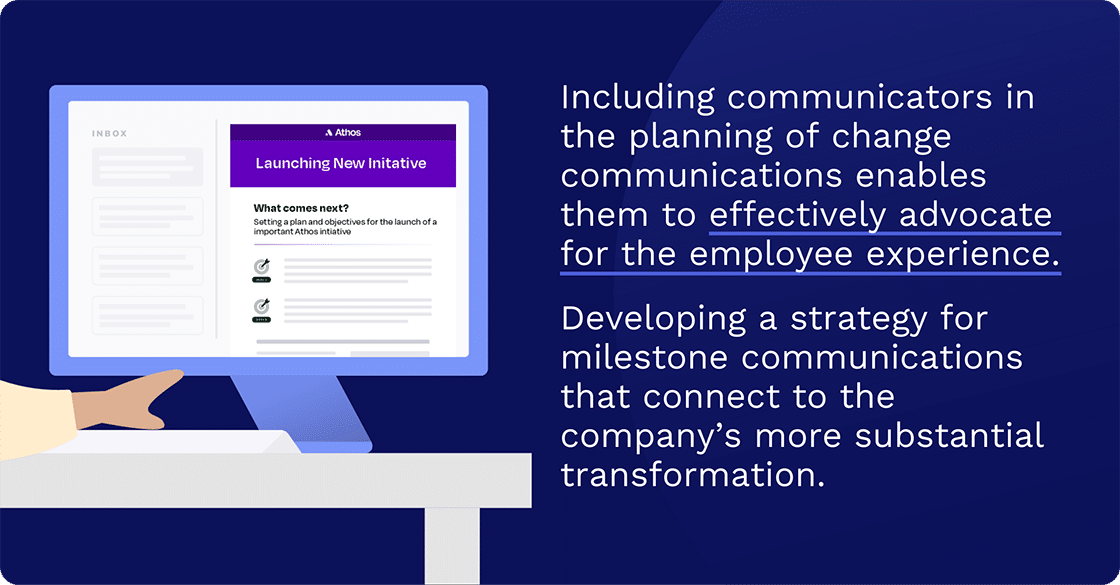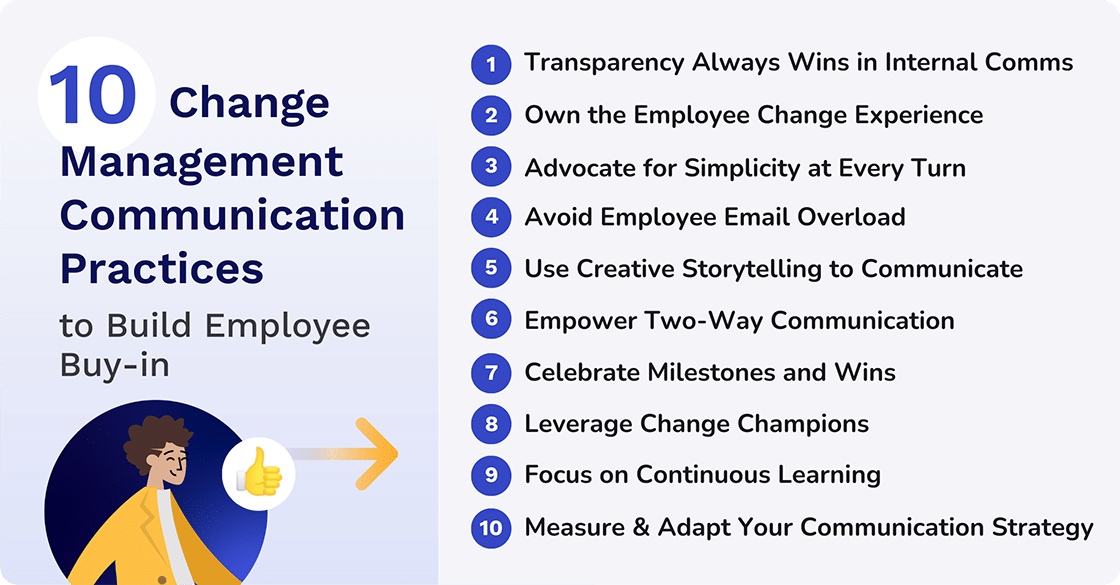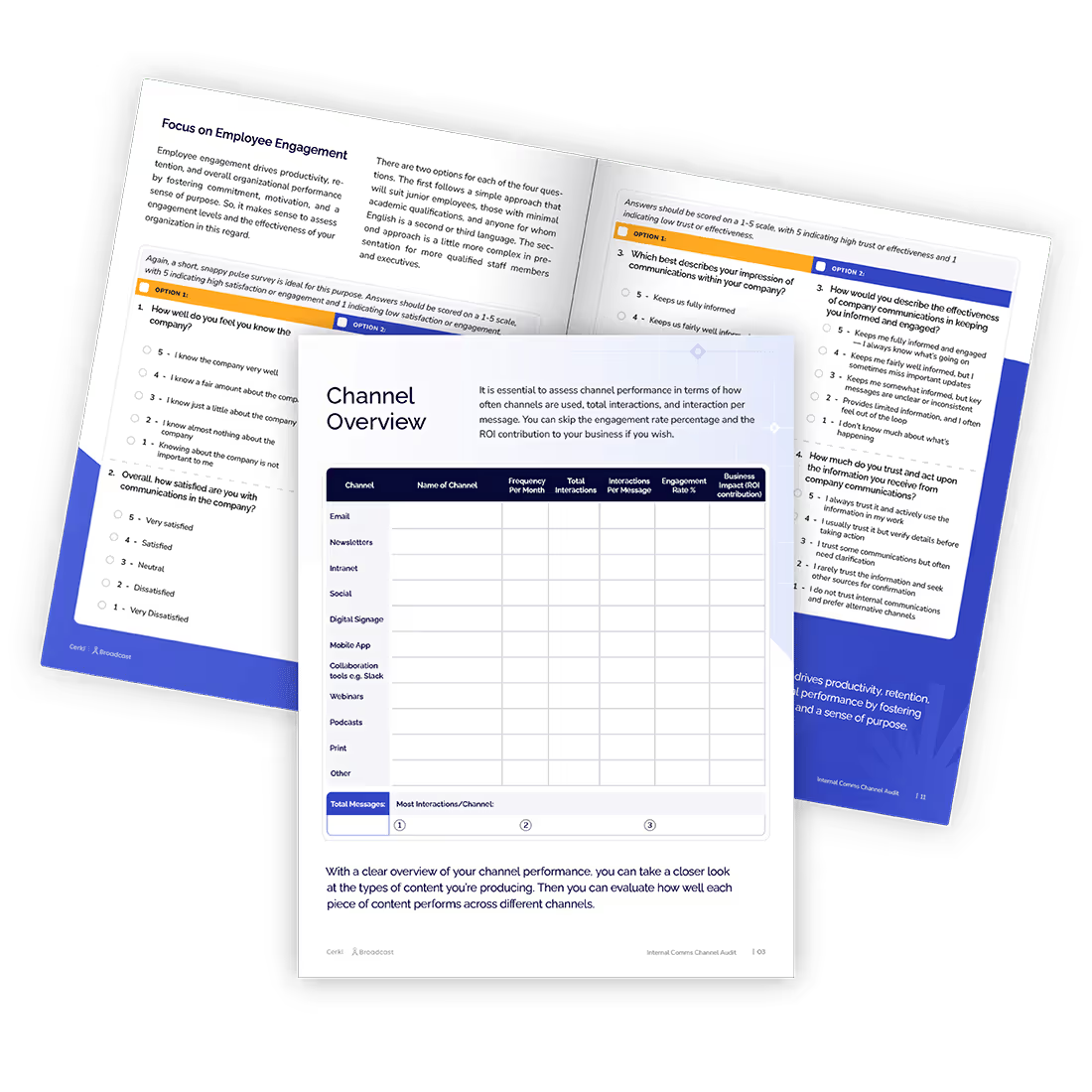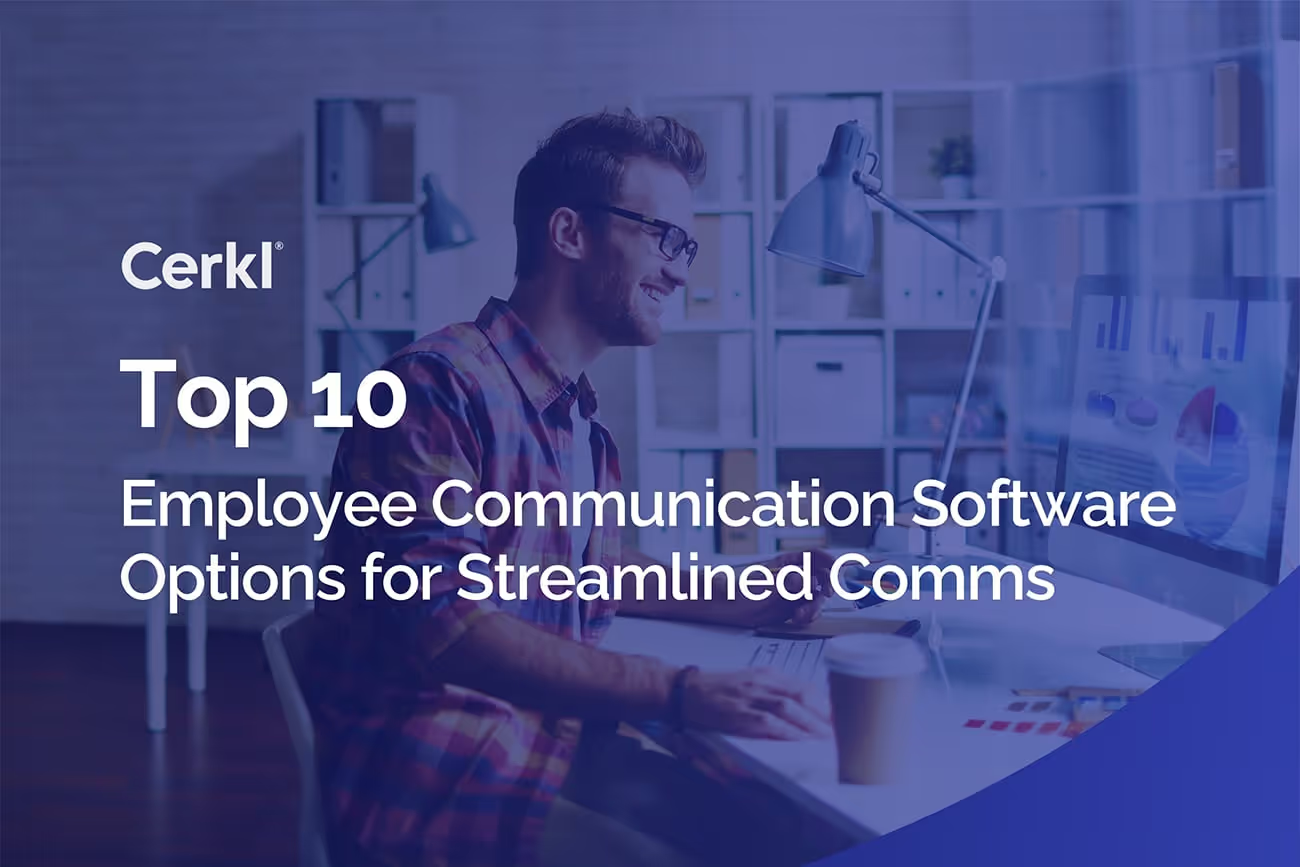 Employee Communication Best Practices
Employee Communication Best Practices
10 Change Communications Best Practices for Internal Transformation
When you are faced with change in an organization, it’s essential to know about change communications best practices. Here’s what you need to know.

.avif)
Audit Your Internal Communications
Strategy is an important component of internal communications. Ensure you’re communicating through the right channels at the right frequency with our Internal Communications Channel Audit worksheet.
Access NowChange is inevitable in any organization. New technologies, evolving markets, and strategic shifts all necessitate adaptation. But without effective communication, even the most well-intentioned changes can lead to confusion, resistance, and sometimes complete failure. This is why effective change management communication is so important.
According to a Gartner survey, change management is one of the top 5 priorities for HR leaders in 2024. However, HR leaders face tremendous challenges. For example, 82% of those surveyed say their managers aren’t equipped to lead change. Additionally, 77% say their employees are fatigued.
The HR leaders indicated that 42% of employees experience change fatigue that impacts their intention to stay with an employer. Nearly a third (30%) said it results in lower levels of trust in employees. More than a quarter (27%) said it makes employees less responsive. And 27% (not necessarily the same people) said employee performance is less sustainable because of change fatigue.
Gallagher’s State of the Sector 2023/24 survey found that change activity was the second-most communicated topic in the business arena. The study report describes change activity as “Change, integration, and M&A activity.”
More than a quarter (27%) of respondents identified it as one of their three top topics. However, just 36% of respondents said employees have a good understanding of what it means. Only new technology elicited a lower employee understanding response, with 35% of respondents ticking this box.
The report also examines managing organizational change — and they highlight a major challenge.
“Results told us that just over half of communicators (51%) are consulted about change after it’s been decided, and then tasked with creating a strategy or plan to communicate it.” Gallagher

That is why it is so important to communicate effectively during organizational change.
What is the Importance of Change Management Communication?
Let’s start by looking at what change management communication is.
Change management communication is the strategic process of informing, engaging, and supporting stakeholders throughout organizational change. It involves delivering clear, consistent, and timely messages to build understanding, acceptance, and commitment to change.
Gallagher refers to change, integration, and M&A. Change is the overall transformation or adjustment an organization is undergoing. Integration specifically focuses on combining different parts or entities into a unified whole, often in the context of mergers or acquisitions (M&A). M&A refers to the consolidation of companies through mergers or acquisitions. A merger involves two companies combining to form a new entity, while an acquisition is one company buying another.
Value of Effective Communication for Organizational Change
Effective communication helps to reduce resistance, increase employee morale, and ultimately, drive successful change implementation. It is crucial because it:
- Reduces resistance: Clear communication addresses concerns and fosters buy-in, minimizing resistance and negativity.
- Increases adoption: When employees understand the "why" behind a change, they're more likely to embrace and adopt new processes or technologies.
- Boosts morale: Effective communication builds trust and transparency, maintaining employee morale during periods of transition.
- Improves efficiency: Clear communication reduces confusion, rework, and misunderstandings, leading to a smoother and more efficient change implementation.

Free Internal Comms Audit Template to Improve Engagement
Upgrade your company’s internal comms to enhance employee communication

Download Free
10 Change Management Communication Practices to Build Employee Buy-In
Now let's explore the top 10 change communications best practices. These will help to guide you and your team through change and transformation.
#1 Transparency Always Wins in Internal Communications
Change that has to go through legal approval in regulated industries or amid deals with publicly traded companies doesn’t mean companies need to remain silent. Educating employees about what can be shared in these instances and why certain aspects must go through regulated approval helps to build trust. Underscoring the company’s commitment to sharing the most critical information as it becomes available also reassures employees during times of vast changes.
Build a resource portal on your intranet with a living list of questions and answers. As the information becomes available, point employees to these resource pages and save organizational updates for more significant milestones. This approach has great value.
#2 Proactively Own the Employee Change Experience
A communication change strategy must be an early part of change planning and embedded within every integration workstream. If communicators are at the planning table and have a degree of autonomy, they can effectively advocate for the employee experience by building strategy into milestone communications that connect to the company’s more substantial transformation.

Insights from the Workday Employee Experience Trends: Top Five Focus Areas for Driving Successful Transformation and Change in 2024 reveal that employee scores for transformation and change are significantly lower on average compared to all other areas of the employee experience. With the pace of change unlikely to slow in 2024, organizations will need to develop a better understanding of how organizational transformation impacts the employee experience.
At the same time, the World Health Organization (WHO) estimates that depression and anxiety costs the global economy more than US$1 trillion every year. And this is predominantly because of reduced productivity!
HR and communicators can work across the company to create content that is multi-dimensional in delivery and to engage employees around change. The reason for the change has to be clear. And employees need to be central in owning change — with avenues for sharing their ideas and giving and getting feedback.
#3 Advocate for Simplicity at Every Turn
Combining different work processes after a merger can be overwhelming due to excessive detail. With mergers or acquisitions, companies must make change easy for their customers or risk losing them to competitors. The same is true for unpacking changes for employees. Integration between legacy companies has to be well thought out and choreographed across all business units. Employee communicators need to partner in lockstep with critical functions such as Learning and Development and HR.
When various features of the business push out their post-merger employee communications, change becomes increasingly complex. As communicators, you serve as a clearinghouse for scheduling communications that are strategic, targeted, and appropriately spaced. Whether it’s a merger or an organization restructuring, communications leadership must be included in understanding the macro business changes and how incremental updates make up the change journey to meet the company’s longer integration goals.
If those involved don’t have this insight, change communications become arbitrary and disjointed. Too much communication outlining smaller changes can result in burnout for employees who tend to disengage. To keep productivity going, communications that cover lots of operational changes have to connect with broader change themes. And these communications have to be relevant to your targeted employee audience.
#4 Avoid Employee Email Overload
Not every communication needs to be sent via email. In 2021, the Radicati Group, a research firm, estimated that daily business and consumer emails would exceed 319 billion. Their forecast was that by the end of 2025, there would be at least 367 billion emails per day.
When you layer on organizational changes and keep abreast of integration, changes can be overwhelming. That’s when you need to consider a communications audit. It’s the best way to discover which platform each employee prefers for company information.
Free Internal Comms Audit Template to Improve Engagement
Upgrade your company’s internal comms to enhance employee communication

Download Free
#5 Use Creative Storytelling to Communicate Change
Communicators must have time to work across the company to create content in multiple formats that reflect leader and employee voices to engage employees around change. Announcements with bulleted information are the go-to form for communicating change, for all forms of change including M&As. But the information will be more likely to stick if it’s coupled with a human-interest story on what the change looks like for the business.
Think about how internal storytelling can be infused to help guide employees through organizational changes. Fun educational trivia contests, leadership Q&As to uncover the foundational work required to lead change across the organization, in-person activities that help teams digest new information, and human interest editorial pieces that spotlight the success of an individual or group. The goal is to mix it up. This is also a critical time to integrate vision, mission, and value statements — sharing the ethos of the company — within all content pieces. Consider written communications that culminate in a leadership roadshow that connects employees with decision-makers in person.
#6 Empower Two-Way Communication
Don't just broadcast messages. Encourage questions, feedback, and open dialogue throughout the change process. Utilize surveys, town halls, or anonymous suggestion boxes to gather employee input and address concerns effectively.
Open and honest communication is essential for building trust during change. Regularly share information about the change process, including its rationale, goals, and timelines. Address grapevine communication promptly to prevent anxiety and speculation. By being transparent, you demonstrate respect for employees and create a foundation for collaboration.
#7 Celebrate Milestones and Wins
Change can be daunting. Recognize and celebrate key milestones and early wins to maintain momentum and keep employees engaged. Highlighting successes reinforces the positive impact of the change and motivates continued effort.
Cultivate a positive and supportive environment throughout the change process. Encourage open communication, collaboration, and problem-solving. Celebrate individual and team successes to boost morale and create a sense of accomplishment. By fostering a positive change culture, you empower employees to overcome challenges and embrace new opportunities.
#8 Leverage Change Champions
Identify and empower employees who are enthusiastic about the change. These change champions can act as internal advocates, answer questions from peers, and provide on-the-ground support during implementation.
Be sure to equip change champions with the necessary training, resources, and authority to effectively fulfill their roles. Recognize and reward their contributions to the change process to boost morale and inspire others. By investing in your change champions, you strengthen their impact and create a multiplier effect for positive change.
#9 Focus on Continuous Learning
Change often requires new skills or knowledge. Provide employees with access to training resources, workshops, or mentorship programs to ensure they have the capabilities to thrive in the new environment.
Encourage employees to embrace a growth mindset and seek opportunities for professional development. Create a learning culture where sharing knowledge and skills is valued. By investing in employee development, you will build a resilient workforce capable of adapting to future changes and challenges.
#10 Measure and Adapt Your Communication Strategy
It is also important to measure and assess the level of success employees are achieving.
Communication is an ongoing process. Regularly track employee sentiment, engagement with communication channels, and understanding of the change. Use this data to identify areas for improvement and adapt your communication strategy as needed. By prioritizing clear, consistent, and employee-centric communication, you can ensure a smoother transition and maximize the success of your change initiatives.
Implement key performance indicators (KPIs) to track the progress and impact of the change initiative. Regularly assess the change's effectiveness in achieving its objectives. Use this data to identify areas for improvement, celebrate successes, and make necessary adjustments to the change strategy.

How Can Cerkl Broadcast Help with Change Management Communication?
There are many ways Cerkl Broadcast can help you improve change management communication.
Cerkl helps companies amplify employee engagement by connecting to existing communication channels to provide a seamless, personalized experience for every employee. Employees can select the company news areas of interest along with the day and time that they’d like to receive the information. Required information will always be prioritized as content that employees must read. For other communications, Cerkl Broadcast uses segmentation to target content to the appropriate audience employees to see what they want to see, ensuring they have read the required information in their preferred channel.
Broadcast gives you analytic tools to find out employee responses to content, track content popularity, and use insights to inform company content strategy. You can also analyze what works with different employee groups across business units and see what particular format.
Just like Netflix or Amazon, the Broadcast solution tracks the content employees are consuming to make future recommendations based on their behavior. Communicators can see which required updates have been read.
When you put the power of company content consumption in employees’ hands with reliable targeting to the right employee audience, you create a personalized experience rather than a one-shot, blanketed email send that employees could miss or delete. With Broadcast, you reserve dedicated email sends to the most time-sensitive, all-employee impacting communications. Our clients have reported that employee engagement soars because employees are paying closer attention to emails reserved for news-breaking announcements.
Our Cerkl Broadcast solution is also hugely powerful when it comes to M&As, which are an important type of organizational change.
What’s Next?
Apart from getting to grips with the importance of internal communications, you should consider doing a communications audit. This will enable you to assess just how successful your internal comms strategy is. It will also help to guide you towards improving it.
The good news is that we have developed an easy-to-use internal communications audit to help you. It’s absolutely free and will help you assess a range of elements from leadership and company strategy to HR company policies.

Free Internal Comms Audit Template to Improve Engagement
Upgrade your company’s internal comms to enhance employee communication
Download Free
FAQ
How do you communicate change effectively? Effective change communication involves clear, consistent messaging that addresses employees' concerns, builds trust, and provides a clear vision of the future. It requires open dialogue and multiple channels of communication.
What are the 5 critical messages of change? Five critical messages of change typically include the reason for change, the impact on employees, the benefits of the change, the steps involved, and the support available during the transition. Some talk about the 5 Cs for clear and effective change communication. These relate to culture, courage, conviction, compassion, and, of course, communication.
What is the best practice for communicating change? The best practice for communicating change is to start early, communicate often and through various channels, listen actively to feedback, and be transparent about the change process. Involve employees in the change wherever possible.








